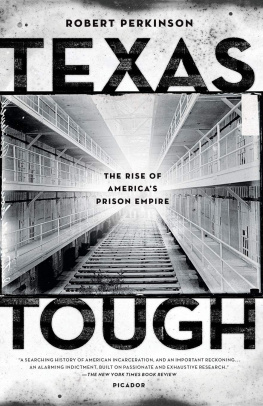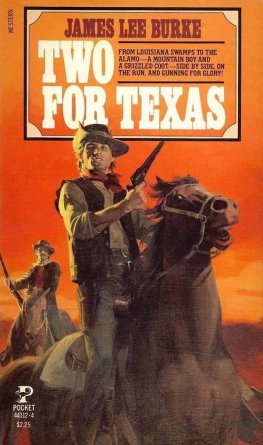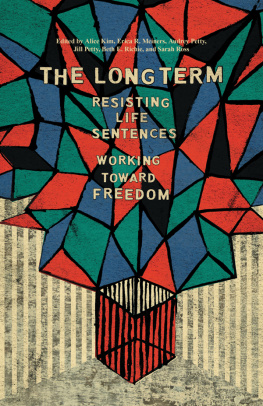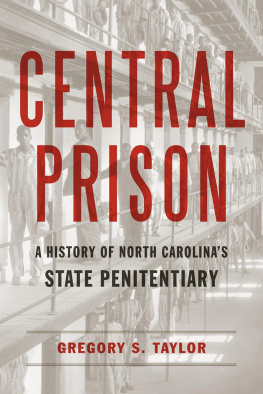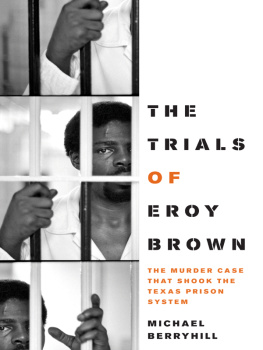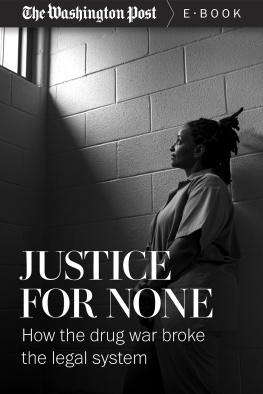THE RISE OF AMERICAS
PRISON EMPIRE
ROBERT PERKINSON
METROPOLITAN BOOKS
HENRY HOLT AND COMPANY NEW YORK
Metropolitan Books
Henry Holt and Company, LLC
Publishers since 1866
175 Fifth Avenue
New York, New York 10010
www.henryholt.com
Metropolitan Books and are registered trademarks of
Henry Holt and Company, LLC.
Copyright 2010 by Robert Perkinson
All rights reserved.
Distributed in Canada by H. B. Fenn and Company Ltd.
The research contained in this document was coordinated in part by the Texas Department of Criminal Justice Project #217-R02. The contents of this report reflect the views of the author and do not necessarily reflect the views or policies of the Texas Department of Criminal Justice.
Library of Congress Cataloging-in-Publication Data
Perkinson, Robert.
Texas tough : the rise of Americas prison empire / Robert Perkinson.1st ed.
p. cm.
Includes bibliographical references.
ISBN: 978-0-8050-8069-8
1. PrisonsTexasHistory. 2. Prison administrationTexasHistory. 3. PrisonersTexasHistory. I. Title.
HV9475.T4P47 2009
365'.9764dc22
2009014670
Henry Holt books are available for special promotions and
premiums. For details contact: Director, Special Markets.
First Edition 2010
Designed by Kelly Too
Printed in the United States of America
1 3 5 7 9 10 8 6 4 2
To my friends behind bars
and their dreams of freedom
CONTENTS
INTRODUCTION
Distrust all in whom the impulse to punish is strong.
FRIEDRICH NIETZSCHE
Freedom is the United States founding creed. Every spot of the old world is overrun with oppression, cried Thomas Paine, but America promises asylum for the persecuted lovers of civil and religious liberty. Andrew Jackson later told his countrymen, Providence has showered on this favored land blessings without number, and has chosen you as the guardians of freedom, to preserve it for the benefit of the human race. Subsequent presidents, in wartime and peace, have renewed this sacred charge, proclaiming freedom as Americas supranational mission, its unifying cause. In his inaugural address, Barack Obama cast the tradition forward. Let it be said by our childrens children, he said, that we carried forth that great gift of freedom and delivered it safely to future generations.
America is the land of the free, yet by one vital measure, it is less free than any other country on earth: it incarcerates a greater portion of its citizenry than any other, about 1 out of every 100 adults. With some 2.4 million persons under lock and key, the United States manages the largest penal system in the world, the grandest ever conceived by a democratic government. Just as slavery once stood as a glaring exception to the American promise, so does imprisonment more than two centuries after the birth of the republic.
The stated purpose of the U.S. prison colossus, which now outstrips the combined populations of Boston, Washington, and San Francisco, is to keep the public safe. Yet the majority of criminologists agree that the phenomenal expansion of incarceration has only modestly reduced crime, accounting for perhaps a quarter of the crime drop since the early 1990s. Even as the experts increasingly doubt the utility of incarceration, however, our society has come to rely on it as never before.
Imprisonment in the United States has achieved unprecedented scale. Combining law enforcement, courts, and prisons, the U.S. criminal justice system consumes $212 billion a year and employs 2.4 million people, more than Wal-Mart and McDonalds combined, the nations two largest private employers. There are more than eighteen hundred separate prisons in operation across the countrynot counting local jails, juvenile lockups, and immigration facilities. Concrete and concertina wire have become integral features of the American landscape.
Even as the use of incarceration has expanded exponentially, however, many Americans still dont know anyone who has been to prison. In middle-and upper-income, predominantly white neighborhoods, imprisonment remains a rare and shocking experience. According to the federal Bureau of Justice Statistics, only one in thirty-nine white men has ever been to prison, with the odds plummeting in the higher income brackets. Along the margins of American society, howeverin poverty-blighted rural areas and struggling urban coresimprisonment has become commonplace. One out of every six African American men has spent time in prison, one out of every thirteen Hispanics. If one takes a snapshot of those currently incarcerated, the socioeconomic indicators read more like a fact sheet from Afghanistan than the first world. Roughly half of todays prison inmates are functionally illiterate. Four out of five criminal defendants qualify as indigent before the courts.
That prisons concentrate poverty and ignorancein addition to rough and shady personalitiesis nothing new. It is well known that most of these individuals on whom the criminal law inflicts punishments, have been unfortunate before they became guilty, noted Gustave de Beaumont and Alexis de Tocqueville in 1833. More surprising is that measurable inequities in criminal justice have widened over the past few decades, particularly across the barrier that has always divided Americans most intractablyrace. A half century agobefore the Montgomery bus boycott, before the War on Poverty, and before the conservative reaction against the social experimentation of the 1960sblacks in the United States were imprisoned at roughly four times the rate of whites. Today, a generation after the triumphs of the civil rights movement, African Americans are incarcerated at seven times the rate of whites, nearly double the disparity measured before desegregation. Although two generations have passed since Brown v. Board of Education, African American men today go to prison at twice the rate they go to college.
Almost no one would have predicted this dire state of affairs two generations ago. Had you proposed in 1965 to increase the U.S. prison expenditures forty-four-fold and widen racial disparities over the next forty years, even the hardest hard-liners would have scoffed. Toward the end of the civil rights era, in fact, most observers believed the country was moving in the opposite direction. Although there is a long way to go, concluded the authors of a 1969 primer on constitutional rights, we are making orderly progress toward the day when the poor man, the Negro, the suspect, and the defender of unpopular causes truly enjoy... equal protection under the law. Conventional prisons, many experts believed, were destined for obsolescence. As counseling and community corrections came to the fore, one of the countrys leading criminologists, Norval Morris, advised criminal justice professions to begin conscious planning for the decline and likely fall of the prison as that term is now understood.
We now know that Professor Morris and his colleagues were not just off the mark but off the map. But why? What, indeed, propelled a resurgence of the prison precisely at the moment of its predicted demise? When I began researching criminal justice in the 1990s, analysts of all stripes were struggling with this question. Law-and-order conservatives had the simplest answers. They argued that cultural hedonism and welfare dependency had gradually eroded family values, unleashing a frightful crime wave in the 1960s that was finally brought under control only by decisive government action. Critics of the crackdown, by contrast, have floated a raft of alternate explanations, from media-driven panic to a reduced tolerance for risk in late modernity. Some have suggested that Americas titanic penal system has reached the point of self-sustaining profitability, that a prison-industrial complex has emerged as a rival to the military-industrial complex first assailed by President Dwight Eisenhower in 1961.

